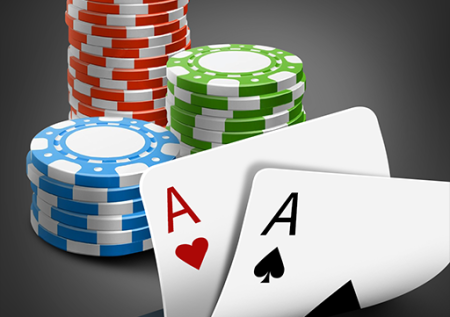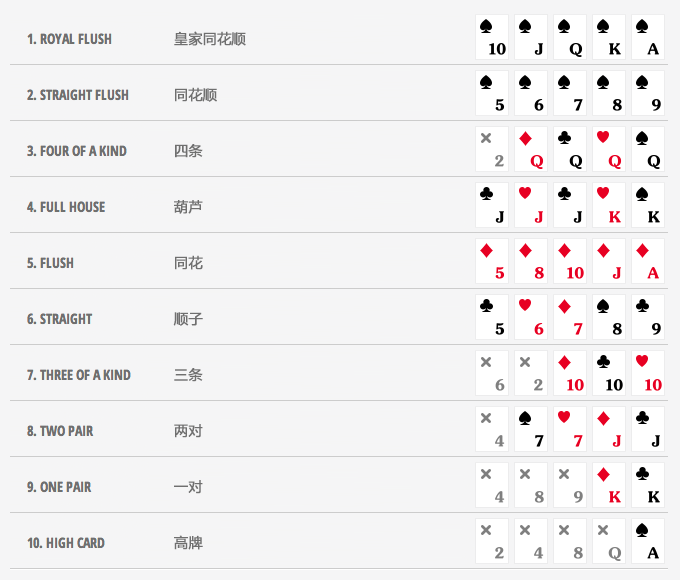


Texas Hold’em uses a deck of cards (excluding the Jokers, a total of 52 cards). At the start, each player is dealt two cards, and then five community cards are dealt in the middle. The players must then select five cards from their hand and the community cards to form the best hand. The player with the highest-ranking hand wins (please refer to the image below).
Blinds: To ensure the game continues, the player to the immediate left of the dealer must place a small blind, and the player to their left must place a big blind (twice the amount of the small blind).
Check: If unsure about the strength of one’s hand, a player may choose to check, which means not placing a bet.
Fold: If a player believes their hand is weak, it is best to fold and exit the round.
Call: If a player believes their hand is decent, they can choose to call, matching the current bet.
Raise: If a player is confident in the strength of their hand, they can choose to raise the bet.
All-In: If a player is extremely confident in their hand, they can choose to go all-in, betting all their chips.
Auto Check: When enabled, the system will automatically check when it is the player’s turn to act.
Auto Check/Fold: When enabled, the system will automatically check if it can or fold if it can’t when it is the player’s turn to act.
Auto Call Any: Regardless of the bet amount, the system will automatically call when it is the player’s turn to act. If there are insufficient funds, the player will go all-in.
Showdown: The player with the best five-card hand, using their two hole cards and five community cards, wins the pot. If two or more players have the same hand, the pot is split equally among them.
Royal Flush > Straight Flush > Four of a Kind > Full House > Flush > Straight > Three of a Kind > Two Pair > One Pair > High Card.
Royal Flush: The highest-ranking straight flush in a single suit.
Straight Flush: A straight in a single suit.
Four of a Kind: Four cards of the same rank and one unrelated card.
Full House: Three cards of the same rank and a pair.
Flush: Five cards of the same suit.
Straight: Five consecutive cards of any suit.
Three of a Kind: Three cards of the same rank and two unrelated cards.
Two Pair: Two pairs and one unrelated card.
One Pair: One pair and three unrelated cards.

Effective Bet/Pot Allocation in Texas Hold’em:
Effective Bet:
The smaller value between the total bet made by a player (my total bet this round) and the highest total bet made by another player.
For example, if Player A has bet a total of 100, and Players B and C have bet totals of 50 and 200 respectively, then Player A’s effective bet is the smaller value between 100 and the maximum value of (50, 200), which is 100.
Pot Allocation:
Due to different betting amounts, multiple pots can be formed (main pot, side pot 1, side pot 2, etc.)
The player with the best hand wins the total amount of each pot they are involved in. The second-best hand wins the remaining pots they are involved in, and so on.
For example, if Player A has bet a total of 1000, Player B has bet 1500, and Player C has bet 2200, there will be multiple pots (please refer to the image below).
If player A has the best hand, B has the second-best hand, and C has the third-best hand, Player A wins the main pot (3000), Player B wins side pot 1 (1000), and Player C wins side pot 2 (700).
If player A and B have the same hand, and C has the third-best hand, Player A and C will split the main pot (3000), Player C wins side pot 1 (1000), and Player C wins side pot 2 (700).